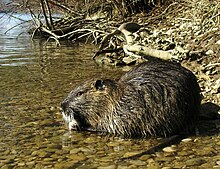
Back كيب (حيوان) Arabic الكيب ARZ Myocastor coypus AST Saskool (Myocastor coypus) AVK Nutriyakimilər Azerbaijani نوتریاکیمیلر AZB Нутрия Bashkir Нутрыя Byelorussian Нутрия Bulgarian Avank-Spagn Breton
| Nutria Temporal range:
| |
|---|---|

| |
| Scientific classification | |
| Domain: | Eukaryota |
| Kingdom: | Animalia |
| Phylum: | Chordata |
| Class: | Mammalia |
| Order: | Rodentia |
| Family: | Echimyidae |
| Subfamily: | Echimyinae |
| Tribe: | Myocastorini |
| Genus: | Myocastor |
| Species: | M. coypus
|
| Binomial name | |
| Myocastor coypus (Molina, 1782)
| |

| |
| The range of the Nutria Regions Extant (resident) Extant & Introduced (resident) Countries Extant & Introduced (resident) Extant (resident) Extant & Introduced
| |
The nutria or coypu (Myocastor coypus)[1][2] is a herbivorous,[3] semiaquatic rodent from South America. Classified for a long time as the only member of the family Myocastoridae,[4] Myocastor is now included within Echimyidae, the family of the spiny rats.[5][6][7] The nutria lives in burrows alongside stretches of water and feeds on river plant stems.[8] Originally native to subtropical and temperate South America, it has since been introduced to North America, Europe and Asia, primarily by fur farmers.[9] Although it is still hunted and trapped for its fur in some regions, its destructive burrowing and feeding habits often bring it into conflict with humans, and it is considered an invasive species in the United States.[10] Nutria also transmit various diseases to humans and animals, mainly through water contamination.[11]
- ^ a b Ojeda, R.; Bidau, C.; Emmons, L. (2017) [errata version of 2016 assessment]. "Myocastor coypus". IUCN Red List of Threatened Species. 2016: e.T14085A121734257. Retrieved 12 March 2022.
- ^ "Myocastor coypus". ITIS. Archived from the original on 18 October 2011. Retrieved 23 September 2011.
- ^ "Myocastor coypus (coypu)". Animal Diversity Web, Museum of Zoology. University of Michigan. 1999. Archived from the original on 2017-08-25. Retrieved 2017-08-25.
- ^ Woods, C. A. (1982). "The history and classification of South American Hystricognath rodents: reflections on the far away and long ago". In Mares, M. A.; Genoways, H. H. (eds.). Mammalian Biology in South America. Pittsburgh: University of Pittsburgh. pp. 377–392.
- ^ Galewski, Thomas; Mauffrey, Jean-François; Leite, Yuri L. R.; Patton, James L.; Douzery, Emmanuel J. P. (2005). "Ecomorphological diversification among South American spiny rats (Rodentia; Echimyidae): a phylogenetic and chronological approach". Molecular Phylogenetics and Evolution. 34 (3): 601–615. Bibcode:2005MolPE..34..601G. doi:10.1016/j.ympev.2004.11.015. PMID 15683932.
- ^ Upham, Nathan S.; Patterson, Bruce D. (2012). "Diversification and biogeography of the Neotropical caviomorph lineage Octodontoidea (Rodentia: Hystricognathi)". Molecular Phylogenetics and Evolution. 63 (2): 417–429. Bibcode:2012MolPE..63..417U. doi:10.1016/j.ympev.2012.01.020. PMID 22327013.
- ^ Fabre, Pierre-Henri; Upham, Nathan S.; Emmons, Louise H.; Justy, Fabienne; Leite, Yuri L. R.; Loss, Ana Carolina; Orlando, Ludovic; Tilak, Marie-Ka; Patterson, Bruce D.; Douzery, Emmanuel J. P. (2017-03-01). "Mitogenomic Phylogeny, Diversification, and Biogeography of South American Spiny Rats". Molecular Biology and Evolution. 34 (3): 613–633. doi:10.1093/molbev/msw261. ISSN 0737-4038. PMID 28025278.

- ^ Taylor, K.; Grace, J.; Marx, B. (May 1997). "The effects of herbivory on neighbor interactions along a coastal marsh gradient". American Journal of Botany. 84 (5): 709. doi:10.2307/2445907. ISSN 0002-9122. JSTOR 2445907. PMID 21708623.

- ^ LeBlanc, Dwight J. (1994). "Prevention and Control of Wildlife Damage – Nutria" (PDF). Animal and Plant Health Inspection Service. Archived from the original (PDF) on 3 February 2007.
- ^ "Living with Wildlife - Nutria". Archived from the original on 2019-03-22. Retrieved 2019-03-22.
- ^ Ca.Gov, Department of Fish and Wildlife. "California's Invaders:Nutria". Archived from the original on 2022-04-30. Retrieved 2022-05-08.
© MMXXIII Rich X Search. We shall prevail. All rights reserved. Rich X Search
